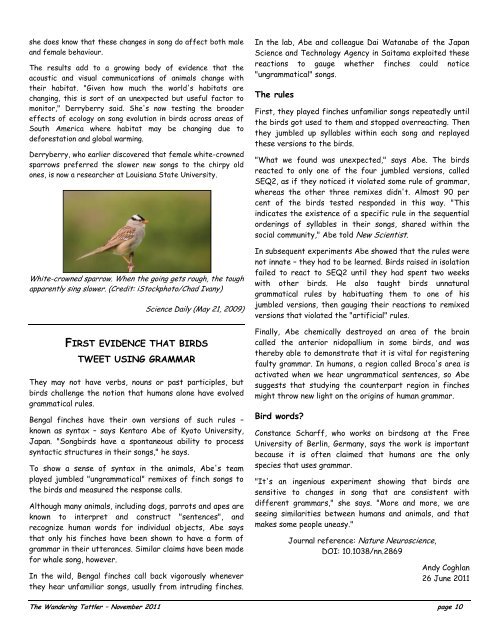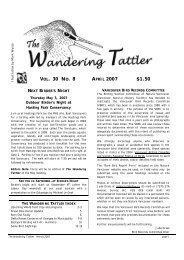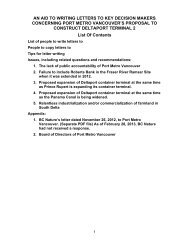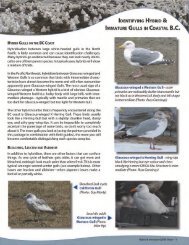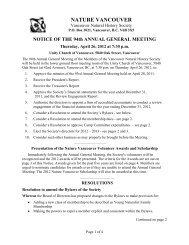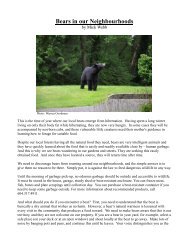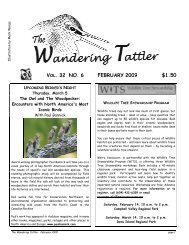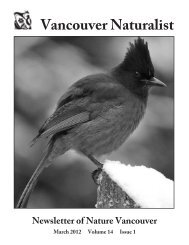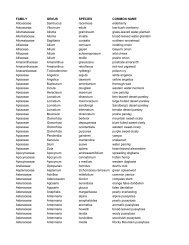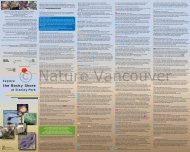Wandering Tattler - November 2011.pdf - Nature Vancouver
Wandering Tattler - November 2011.pdf - Nature Vancouver
Wandering Tattler - November 2011.pdf - Nature Vancouver
Create successful ePaper yourself
Turn your PDF publications into a flip-book with our unique Google optimized e-Paper software.
she does know that these changes in song do affect both maleand female behaviour.The results add to a growing body of evidence that theacoustic and visual communications of animals change withtheir habitat. "Given how much the world's habitats arechanging, this is sort of an unexpected but useful factor tomonitor," Derryberry said. She's now testing the broadereffects of ecology on song evolution in birds across areas ofSouth America where habitat may be changing due todeforestation and global warming.Derryberry, who earlier discovered that female white-crownedsparrows preferred the slower new songs to the chirpy oldones, is now a researcher at Louisiana State University.White-crowned sparrow. When the going gets rough, the toughapparently sing slower. (Credit: iStockphoto/Chad Ivany)Science Daily (May 21, 2009)FIRST EVIDENCE THAT BIRDSTWEET USING GRAMMARThey may not have verbs, nouns or past participles, butbirds challenge the notion that humans alone have evolvedgrammatical rules.Bengal finches have their own versions of such rules –known as syntax – says Kentaro Abe of Kyoto University,Japan. "Songbirds have a spontaneous ability to processsyntactic structures in their songs," he says.To show a sense of syntax in the animals, Abe's teamplayed jumbled "ungrammatical" remixes of finch songs tothe birds and measured the response calls.Although many animals, including dogs, parrots and apes areknown to interpret and construct "sentences", andrecognize human words for individual objects, Abe saysthat only his finches have been shown to have a form ofgrammar in their utterances. Similar claims have been madefor whale song, however.In the wild, Bengal finches call back vigorously wheneverthey hear unfamiliar songs, usually from intruding finches.In the lab, Abe and colleague Dai Watanabe of the JapanScience and Technology Agency in Saitama exploited thesereactions to gauge whether finches could notice"ungrammatical" songs.The rulesFirst, they played finches unfamiliar songs repeatedly untilthe birds got used to them and stopped overreacting. Thenthey jumbled up syllables within each song and replayedthese versions to the birds."What we found was unexpected," says Abe. The birdsreacted to only one of the four jumbled versions, calledSEQ2, as if they noticed it violated some rule of grammar,whereas the other three remixes didn't. Almost 90 percent of the birds tested responded in this way. "Thisindicates the existence of a specific rule in the sequentialorderings of syllables in their songs, shared within thesocial community," Abe told New Scientist.In subsequent experiments Abe showed that the rules werenot innate – they had to be learned. Birds raised in isolationfailed to react to SEQ2 until they had spent two weekswith other birds. He also taught birds unnaturalgrammatical rules by habituating them to one of hisjumbled versions, then gauging their reactions to remixedversions that violated the "artificial" rules.Finally, Abe chemically destroyed an area of the braincalled the anterior nidopallium in some birds, and wasthereby able to demonstrate that it is vital for registeringfaulty grammar. In humans, a region called Broca's area isactivated when we hear ungrammatical sentences, so Abesuggests that studying the counterpart region in finchesmight throw new light on the origins of human grammar.Bird words?Constance Scharff, who works on birdsong at the FreeUniversity of Berlin, Germany, says the work is importantbecause it is often claimed that humans are the onlyspecies that uses grammar."It's an ingenious experiment showing that birds aresensitive to changes in song that are consistent withdifferent grammars," she says. "More and more, we areseeing similarities between humans and animals, and thatmakes some people uneasy."Journal reference: <strong>Nature</strong> Neuroscience,DOI: 10.1038/nn.2869Andy Coghlan26 June 2011The <strong>Wandering</strong> <strong>Tattler</strong> – <strong>November</strong> 2011 page 10


